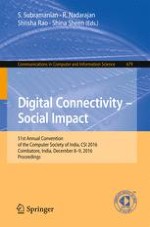2016 | Book
Digital Connectivity – Social Impact
51st Annual Convention of the Computer Society of India, CSI 2016, Coimbatore, India, December 8-9, 2016, Proceedings
Editors: S. Subramanian, R. Nadarajan, Shrisha Rao, Shina Sheen
Publisher: Springer Nature Singapore
Book Series : Communications in Computer and Information Science
